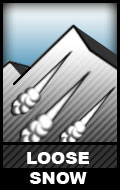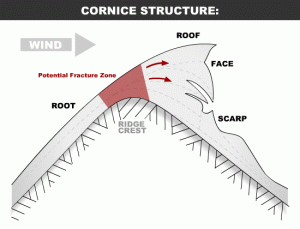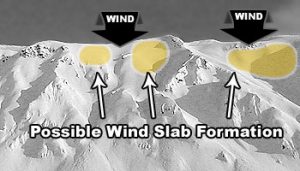Avalanche Danger Forecast
Issued Wednesday, March 10, 2021 at noon for the greater Anchorage area Western Chugach Mountains (i.e. Chugach State Park). View map of primary forecast area here.
Dangerous avalanches conditions will exist in Chugach State Park through Thursday due to several inches of new snow and strong wind.
Through Thursday it will be VERY important to be aware of steep terrain above you even if you’re on relatively flat terrain, as it will be possible for humans to remote trigger avalanches and natural avalanches might run into flat low elevation terrain. Popular trails in Chugach State Park (e.g. Penguin Ridge and Falls Creek from Turnagain Arm, Powerline from Glen Alps along the north side of the Flattop-Flaketop ridge, Upper South Fork Eagle River near Eagle Lake) cross potentially dangerous avalanche paths that may run naturally Wednesday-Thursday. Make sure you know how to identify avalanche terrain and don’t linger under avalanche paths that cross trails.
Avalanche danger is then expected to decrease to moderate through the weekend, but remember that 34% of avalanche fatalities occur when the danger rating is moderate.
Don’t be lured into potentially dangerous terrain by the sunshine and fresh snow.
It will be VERY important to assess the snowpack where you intend to recreate this weekend, understand the potential consequences of exposure to avalanche terrain, practice safe travel protocols, and have a plan for any mishaps.
While the likelihood of triggering an avalanche is expected to decrease through the weekend, the Chugach State Park snowpack will still be adjusting to a significant new load from Tuesday-Thursday’s snowfall and wind loading. Additionally, bouts of moderate to strong winds in the upper elevations through the weekend may continue to build fresh wind slabs from the recent snow and further stress persistent slabs.
Wind slabs will be the primary avalanche problem but persistent slabs are expected to be “reawakened,” and more prone to human triggering, from the new snow and wind loading.
Sluffs and cornice falls are additional concerns to keep in mind. Cornices are expected to grow significantly from the Tuesday-Thursday snow and wind event and be especially prone to falling. Cornice falls could trigger avalanches.
Mountain Weather:
Wednesday: snow developing, temps in the 20s, moderate to strong east to south wind
Thursday: snow, temps in the low teens to single digits, light to strong northerly wind
Friday: sunny, temps in the low teens to single digits, light to moderate northerly wind (possibly strong in areas more exposed to outflow)
Saturday: sunny, temps in the low teens to single digits, light to moderate northerly wind
Sunday: increasing clouds, temps in the teens to low 20s, increasing east to south wind
Avalanche Problems:
 Wind slabs up to D2.5 in size above 2000′ on leeward terrain steeper than 35º. These may be triggered naturally or by humans remotely through Thursday. They may run into much lower elevation terrain near sea level.
Wind slabs up to D2.5 in size above 2000′ on leeward terrain steeper than 35º. These may be triggered naturally or by humans remotely through Thursday. They may run into much lower elevation terrain near sea level.
Winds will shift through the forecast period and due to the terrain of the park channeling winds in varying directions, watch for wind slabs on all aspects.
Active wind loading, recent avalanches, and shooting cracks are red flag indicators of wind slab danger. Wind slabs are most likely to exist below corniced areas and along the lee sides of ridges and cross-loaded features like gullies:
Relatively densely-packed (firm and “punchier” feeling) snow and pockets of deeper snow (especially with a bulbous or fat appearance) are indicators of wind slabs. If you look closely at the snow surface you may be able to distinguish where wind slabs exist due to the snow having a more textured, densely-packed, consolidated, cohesive, and/or striated appearance. Be especially wary of (and avoid) steep, convex, and/or unsupported wind loaded terrain features.
Pole probing and hand pits are a quick and effective means of assessing this problem as you travel. Use pole probing to quickly feel out areas of denser, wind-packed snow overlying looser and weaker snow. Use hand pits to quickly assess how near-surface layers of snow are bonded.
Digging a snowpit and conducting a compression test and/or extended column test will provide an even better assessment of bonding and instability before you travel on terrain of consequence.
You can also assess wind slab instability via safer “test slopes” that are representative of higher consequence terrain.
Persistent slabs up to D3 in size above 2000′ on terrain steeper than 35º. These may be triggered naturally or by humans remotely through Thursday. They may run into much lower elevation terrain near sea level.
While persistent slabs may exist on all aspects, expect the problem to be the most pronounced in areas with a generally thinner and weaker snowpack as well as on shadier and colder northerly aspects (where the temperature gradient has promoted a weakening metamorphism [faceting] of the snowpack and is relatively adverse to bonding and stabilization of buried persistent weak layers).
While persistent slabs are a lower probability avalanche problem than wind slabs, the probability of them being triggered during this forecast period will be higher than it has been for many weeks and they may be more likely in the coming days than at any other time this season. They will also be much larger and more dangerous than wind slabs. They could be hard slabs that break deeper down in the snowpack and release above and around a human trigger (rather than at the trigger’s feet) which can make escape difficult. Hard slab avalanche debris is also more likely to cause trauma than debris from soft slabs.
Be on the lookout for red flag warnings of persistent slab danger: recent avalanches, collapsing (aka “whumphing“), and shooting cracks.
Diverse and widespread persistent weak layers exist in the snowpack. Faceted snow exists above and below crusts in some areas, sandwiched between wind packed layers in many areas, and a basal weak layer of advanced facets and depth hoar is widespread. Surface hoar may also exist in isolated areas.
 Dry loose snow avalanches (human triggered sluffing and naturally triggered spindrift) are possible above 3000′ on steep terrain (38º+) across all aspects.
Dry loose snow avalanches (human triggered sluffing and naturally triggered spindrift) are possible above 3000′ on steep terrain (38º+) across all aspects.
While these relatively small avalanches (D1) aren’t much of a concern in regard to burial, they do have the potential to cause a fall or loss of control. They could also step down and trigger a larger and more dangerous slab avalanche.
Don’t let a loose snow avalanche catch you off guard. Manage your sluff if descending via ski or snowboard steep and wind-sheltered terrain with loose and uncohesive snow. If it’s windy and you’re climbing steep and/or exposed terrain, be mindful of the potential for heavy spindrift that could knock you off your feet and take you for a (potentially deadly) ride.
Cornices are large and overhanging in some areas above 2000′. New snow and wind will make them larger and more prone to failure and falling this forecast period.
Be mindful of corniced slopes above you. A falling cornice may “bomb” the slope it lands on and trigger an avalanche. Give cornices a wide berth and don’t approach the edge of a ridge to look down slope unless you’re sure it’s not corniced. Cornices can break off further back than expected (even beyond the true edge of the mountain ridge beneath the snow surface).
Terrain management is always the best way to deal with avalanche problems: eliminate or reduce your exposure to terrain capable of producing an avalanche. Before traveling on or under terrain that has the potential to avalanche think about the consequences and have a plan (to escape the avalanche, for re-grouping, and rescue).
Always be mindful of terrain traps that can make even a small avalanche deadly.
Click the hyperlinks and icons to learn more.
Please let us know what you’re seeing by tagging us on Instagram @anchorage_avalanche_center, submitting an observation, sending an email to info@anchorageavalanchecenter.org, or via FaceBook message. All observations help us provide a better forecast product (no matter how basic). We can keep your observation confidential, and only use the information to inform forecast products.





